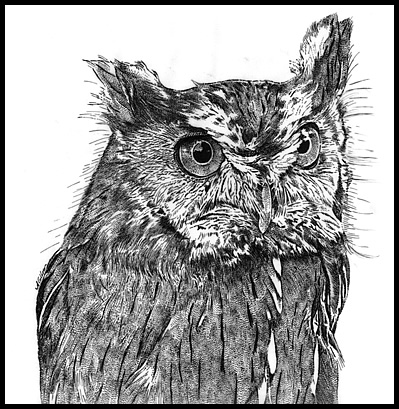| |
| |
| |
| |
| |
| |
| |
| |
| |
| |
| EASTERN
SCREECH OWL Otus asio |

|
The soda-can-size screech owl is the smallest owl with ear tufts found in the Northeast. The species averages just seven ounces in weight, and between eight and nine inches in length. As is the case with almost all owls, female screech owls are larger than the males. Despite its diminutive size, this is an audacious owl, one that will attack birds and mammals much larger than itself if it is hungry enough. Screech owls have been known to kill prey the size of ruffed grouse and domestic chickens and ducks. Typical prey, however, would consist of small rodents such as mice and voles. Vast numbers of insects are taken in the summer, and the diet is rounded out with small birds, reptiles, amphibians and even fish. The screech owl comes in two color phases, gray and rusty-red. This color difference is unrelated to age, sex, or season. It may be related to geographic distribution - gray birds tend to live in areas of evergreen forest, while red birds tend to be found in areas of deciduous forest. Both colors are marked with a complicated and camouflaging barklike pattern that renders a perched bird almost invisible. Aids in camouflage are the owl's ear tufts, which can be erected and lowered at will. When a screech owl goes on the alert, it raises the ear tufts, pulls its feathers in tightly, and narrows its eyes to slits. The result is an uncannily accurate imitation of a tree branch, an imitation the owl enhances by remaining motionless until the danger has passed. The screech owl is a year-round resident throughout most of its range. In the Northeast typical habitat is a wooded area that includes open fields and a water source. In years gone by the owl frequently nested in orchards, living well on the abundant rodent, bird and insect life found there. Today, however, fruitgrowers' heavy reliance on pesticides means that orchards are no longer fruitful places for screech owls. The species will live close to human habitation, and will accept man-made nesting boxes of the type designed for the American kestrel or the wood duck. Eggs average four, although more may be laid if food is plentiful. Incubation lasts approximately 26 days. Screech owls will vigorously defend their young, and will even attack people who venture too close to the nest. When young screech owls are in their fourth or fifth week, they leave the nest, even though they are still too young to fly. Their clambering about on tree branches seems to be a kind of warm-up exercise for flight. At this stage many young birds end up on the ground, and there they are sometimes found by people who assume that they are orphaned and in need of human care. In fact the parent owls are still feeding the young birds, and the babies should be left where they are. Reared by humans, they will irreversibly imprint to people and have to remain in captivity. The attractive little screech owl has been saddled with an unfortunate name. The species' typical cry is not a screech at all but a haunting, quavering trill, quite melodic in nature. The call has an eerie, ventriloquial quality that makes pinpointing its source very difficult. |